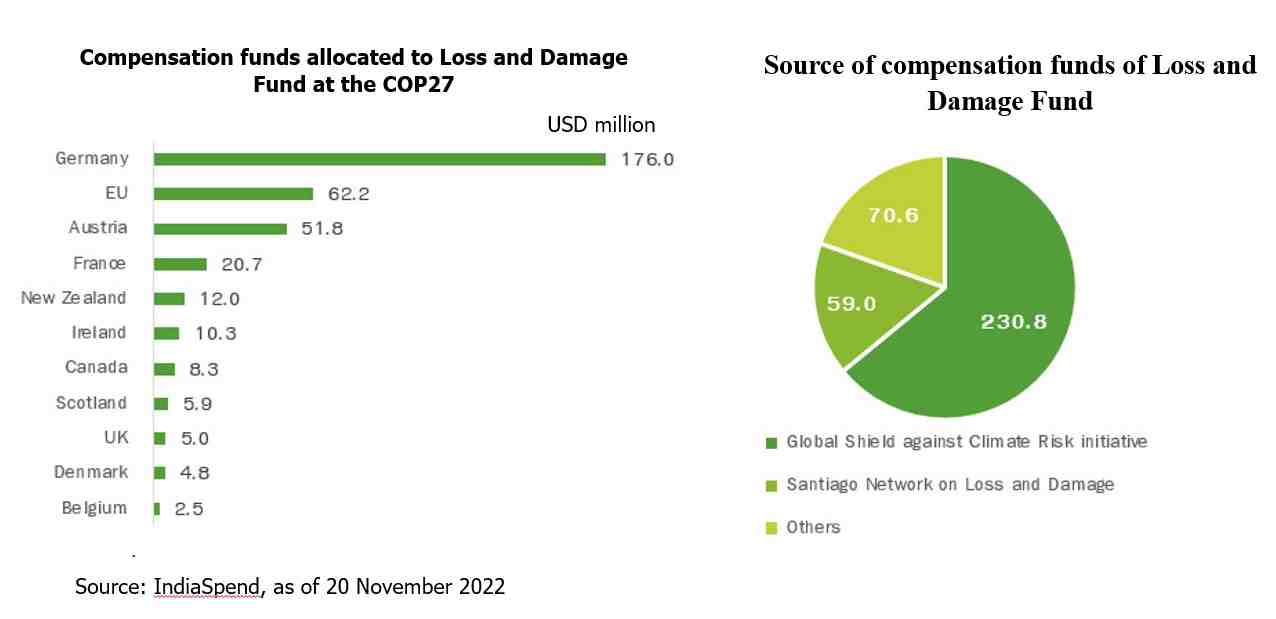On November 20, 2022, the 27th session of the Conference of the Parties (COP27) to the United Nations Framework Convention on Climate Change (UNFCCC) reached an agreement to establish a fund to respond to loss and damage resulting from climate change (Loss and Damage Fund), which aims to help developing countries affected by climate change through funding from developed countries or wealthy countries. In addition, the conference warns members that the current global average temperature is 1.1 degree Celsius higher than the 19th century baseline and that the carbon dioxide in the atmosphere now has increased by more than 50% from the 19th century baseline. The Intergovernmental Panel on Climate Change (IPCC) projects that if global temperature rises by more than 1.5 degree Celsius by the end of this century, the damage caused to the world will reach USD54-69 trillion.1
The Fund’s loss and damage compensations differs from other existing funds addressing climate change that focus on reducing carbon dioxide emissions or adapting to transition to address potential environmental impacts ahead. The Loss and Damage Fund will focus on allocating funds to compensate vulnerable countries that are unable to avoid or adapt to the impact of climate change, especially developing countries with scarce financial sources. The funds will be allocated by developed countries as they are the major emitters of CO2 emissions since the industrial revolution.

Currently, many developed countries have pledged funds to the Loss and Damage Fund to compensate for loss and damage from climate change through 3 channels – the Santiago Network2 , the Global Shield Against Climate Risks initiative3 and other channels - totaling approximately USD360 million. This is a good starting point for action to offset the impact of climate change.
However, the criteria for determining how much compensation must be paid by each developed country, or which countries are subject to such compensation, remains open to further discussion. Initially, the COP27 conference announced the Sharm el-Sheikh Implementation Plan4 and established a transitional committee to deliberate arrangements for the Fund, which is scheduled to hold at least 3 meetings before next year’s COP28 conference at the United Arab Emirates.
Other issues related to the investment
The COP27 conference also focuses on tracking developed countries’ previous commitment to provide USD100 billion per year in aid through Climate Finance to developing countries and underdeveloped countries, as there is still a USD16.7 billion5 shortfall from the expected target. In addition, the transition toward a low carbon society would require an investment of at least USD4-6 trillion per year to achieve the net zero target by 2050, but only USD0.8 trillion6 was invested during 2019-2020.
--------------------------------------------------------------------------------------------
1
IPCC special report: Global Warming of 1.5 C (https://www.ipcc.ch/sr15/)
2 Established at the COP25 conference in Madrid, Spain in 2019 to provide technical support and resources to developing countries (https://unfccc.int/santiago-network/about)
3 Established at COP27 by the Group of Seven (G7) and the Vulnerable Twenty (V20) Group which consists of 58 members countries that are vulnerable to climate change (https://unfccc-events.azureedge.net/COP27_89038/agenda)
4 Sharm el-Sheikh Implementation Plan (https://unfccc.int/sites/default/files/resource/cma4_auv_8f.pdf)
5UNFCCC Standing Committee on Finance (https://unfccc.int/sites/default/files/resource/J0156_UNFCCC%20100BN%202022%20Report_Book_v3.2.pdf)
6UNFCCC Standing Committee on Finance (https://unfccc.int/sites/default/files/resource/J0156_UNFCCC%20BA5_2022_Report_v4%5B52%5D.pdf)
Scan QR Code

Annotation
This research paper is published for general public. It is made up of various sources. Trustworthy, but the company can not authenticate. reliability The information may be changed at any time without prior notice. Data users need to be careful about the use of information. The Company will not be liable to any user or person for any damages arising from such use. The information in this report does not constitute an offer. Or advice on business decisions Anyhow.